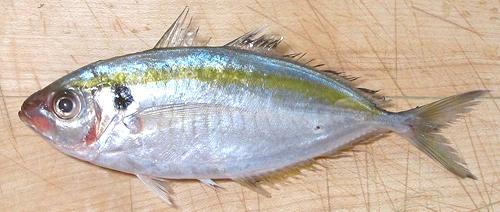
1: Cleaning

2: Deep Fried, fins pulled out,
ready to serve.

3: Deep fried and eaten

4: Deep fried, eaten another way.
Use thin chopsticks for this.

5: Steamed, fins pulled out
This is a rather small fish, but quite popular in the Philippines. It can be enjoyed without too much hassle if you know how to do it.
The easiest way to eat this fish is to remove the head, clean out the body, and deep fry it. Deep frying will crisp the thin ribs into edibility, which pan frying, poaching or baking will not do. Once fried, pull out the fins from top and bottom and it's ready to serve (Photo-2). If you steam or bake, you can still pull out the fins (Photo-5), but you'll have to deal with the thin ribs on the plate.
I always eat fish of this sort with chopsticks, which give me total control of how the fish is disassembled. I accompany it with my favorite Lemon Wine Sauce, which does not mask the taste of the fish. I'm paying for fish, so I want to taste fish.
Deep frying doesn't usually need a coating, but for pan frying I use a light dusting of rice flour to prevent sticking and hold delicate fillets together. Again, rice flour doesn't mask the taste of the fish, but be aware it doesn't brown much - your fish will still be fish color too.
Buying: Like other scads, Yellow Stripe Scad is found mostly in Philippine fish markets, where it is often sold as Yellowstripe Trevally, or Salay Salay. Here in Los Angeles we have a Philippine market near every major hospital complex, because our health care system runs mainly on Filipino immigrants. The photo specimen was purchased at a large Philippine market in Eagle Rock, for 2016 US $2.99 / pound.
Scales: Like other scad, this one has a few scales up near the head end, but they are extremely tiny, and tend to rub off, so don't worry about them.
Scutes: As with other "hard tail" fish it has hard "scutes" along the lateral line near the tail, but for this fish they are too small to be a problem, especially when frying.
Cleaning: This fish can be cleaned and filleted just like any larger fish, if you have moderate sized hands and are good at delicate work. The easiest way to clean it is to cut off the head, but it can be cleaned head-on.
- Snip off the keel with your kitchen shears, from right behind the head back until it takes out the sharp spines a bit in front of the anal fin (bottom of Photo-1). This will also take out the pelvic fins and open the body cavity for cleaning.
- Note that there is a sharp bone right at the front of the cut you have made, but it pulls out easily.
- If you are cutting off the head, make a cut on both sides from the top of the head around behind the pelvic fins and down under the chin. Use you kitchen shears, following this cut from the top, to break the backbone, then pull the head forward and down, and most of the innards will come with it. Scrape any remaining stuff out of the body.
- If you are leaving the head on, you'll have to dig out the innards with your little finger, then pull the gills with your long nose pliers. They pull easily, but the aperture is too small for fingers. Rinse out the head and body well, scraping out any gooky stuff.
Fillet: Filleting this fish is rather easy, but a bit tedious since you'll have so many fish to fillet, which is why I suggest deep frying with the bones and fins in..
- Remove the head and cut off the tail.
- Make cuts on both sides of the anal fin, from where the tail was to the body cavity, aiming the knife towards the backbone.
- Cut down from both sides of the dorsal fins to the backbone. At the tail end go over the backbone and cut forward to the rib cage.
- At the rib cage, you can just break the ribs from the backbone. Pull them out 2 to 3 at a time with your long nose pliers.
- If you will be cooking by a method other than frying, you might want to pull the first few centerline pin bones. Farther back they are too soft to worry about.
Yield Yield is quite good for a small fish. A batch of 12 fish weighing 1 pound 4-5/8 ounces yielded 10-5/8 ounces of skin on fillet (52%). The fillets come out very cleanly, so that's about all you can get by any other method of cooking.
 [Yellowstripe Trevally (Market); Salay-salay (Philippines);
Selaroides leptolepis]
[Yellowstripe Trevally (Market); Salay-salay (Philippines);
Selaroides leptolepis]